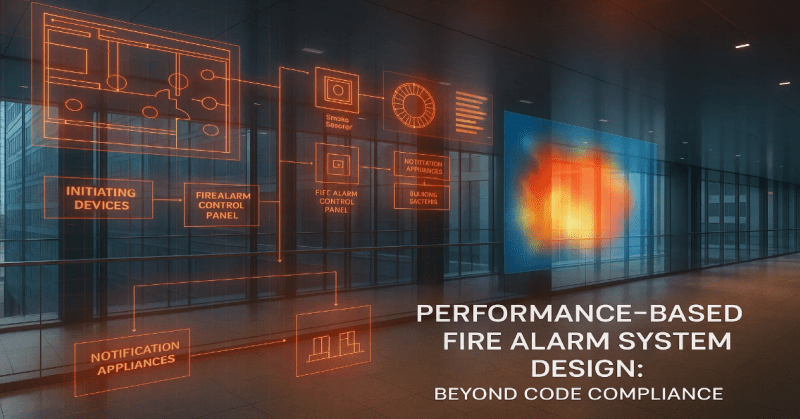Performance-Based Fire Alarm System Design tailors fire safety strategies to a building’s unique needs. Unlike one-size-fits-all code compliance, it uses risk analysis and modern tools to meet specific safety goals.
This approach is especially relevant for complex Indian buildings (hospitals, malls, airports, etc.) where prescriptive rules may not cover all hazards. Performance-based design often leads to more effective, flexible and innovative fire safety solutions.
As demonstrated in advanced projects, performance-based designs can yield better safety and efficiency than standard systems.

Code-Compliant vs Performance-Based Design
Prescriptive (code-based) fire alarm design follows fixed rules set by standards like NBC 2016, Indian Standards (IS), or NFPA 72. It specifies sensor spacing and alarm devices in a one-size-fits-all way. In contrast, a performance-based approach starts with a fire risk assessment and safety objectives, then uses engineering analysis to meet those targets. The table below summarizes key differences:
| Aspect | Code-Compliant (Prescriptive) | Performance-Based |
|---|---|---|
| Approach | Fixed rules and code requirements | Goals-based design using risk analysis |
| Flexibility | Limited – must follow code tables | High – customized to each project |
| Design Tools | Basic calculations, standard charts | Advanced modeling (fire/egress simulation) |
| Scope | Typical building types (standard occupancies) | Any structure (unique or complex projects) |
| Safety Focus | Meets minimum code standards | Targets real outcomes (e.g. evacuation time, smoke control) |
| Examples | Regular homes or office buildings | High-rises, hospitals, malls, airports, data centers |
Benefits for Complex Indian Buildings
Performance-based design offers clear advantages in diverse, challenging facilities. Complex occupancies pose risks that standard codes may overlook. For example:
- Hospitals: Patients, medical equipment and oxygen-enriched air require precise detection and evacuation planning. A performance-based design can model patient evacuation and optimize alarm zones accordingly.
- High-Rise Towers: Tall buildings need custom analysis of smoke travel and stairwell performance. Performance-based models help ensure alarms reach all floors and occupants in time.
- Shopping Malls and Airports: Vast open areas with crowds require wide-area detection and clear evacuation messaging. Tailored designs account for atriums, large concourses and peak occupancy levels.
- Data Centers: Critical IT environments run continuously. Designing alarms with very early smoke detection and minimal false alarms protects equipment and operations.
In each case, engineers use data about occupancy, fire loads and building layout to design an optimal alarm system. By focusing on actual fire scenarios and risks, these systems improve life safety and operational efficiency.
Key Components of Performance-Based Design
Effective Performance-Based Fire Alarm System Design involves several key steps and tools:
- Performance Criteria: Establish clear safety goals (e.g. maximum evacuation time, smoke layer height) based on stakeholder needs. These criteria guide the design and define acceptable outcomes.
- Risk Assessment: Evaluate hazards by analyzing building use, occupancy, fire load and fire department response time. This sets the stage for defining what the system must achieve.
- Fire Modeling: Use computer simulations (smoke dispersion, heat, egress models) to predict fire behavior and evacuation under different scenarios. Modeling identifies vulnerabilities (like areas of smoke accumulation or weak alarm coverage).
- Customized Detection: Based on analysis, select and place detectors (smoke, heat, aspirating, etc.) to meet coverage and sensitivity goals. For example, designers might use multi-sensor detectors or addressable systems in specific zones.
- Evacuation Planning: Simulate occupant evacuation to ensure alarms and exits provide enough time to escape. This may involve adjusting stairwell design, exit widths, or alarm tone sequencing for different areas.
- Smart Building Integration: Connect the fire alarm with building management and IoT systems for automated response. For instance, a fire signal can trigger smoke vents, shut down HVAC/escaltors and send alerts via the building’s central monitoring system.
These elements ensure the fire alarm system meets the defined performance objectives, not just the minimum code checks.
Note: This approach requires advanced expertise and detailed analysis to prove the design, often involving collaboration with authorities.
Detailed Benefits of Performance-Based Design
- Tailored Safety Solutions: The design directly addresses the building’s unique layout and occupancy, rather than applying a generic template.
- Enhanced Life Safety: By focusing on real outcomes (safe evacuation, fire containment), performance-based systems can provide superior protection.
- Cost Efficiency: Resources target the most critical hazards, potentially reducing unnecessary equipment and installation costs.
- Technological Innovation: Designers can incorporate new technologies (advanced detectors, analytics, voice alarms) without being constrained by rigid codes.
- Integrated Response: Alarms become part of a smart ecosystem. For example, a coordinated system might simultaneously trigger smoke vents, alarms and emergency lighting during a fire.
- Regulatory Confidence: By demonstrating that the design meets specific safety criteria, engineers can satisfy regulators even if the approach differs from prescriptive norms.
In short, performance-based design often yields more effective, flexible, and cost-smart fire alarm solutions for demanding projects.
Alignment with Indian and International Standards
Indian codes like the National Building Code (NBC 2016) and related IS standards are mainly prescriptive. NBC Part 4 specifies fire zones, detectors, alarm requirements and egress for standard occupancies.
It does not require performance-based methods for new buildings, although a performance-based design annex (Annex N) is included for heritage or special cases. Likewise, IS codes (e.g. IS 2189 for smoke detectors, IS 3414 for fire alarms) define equipment and layouts.
However, performance-based design can complement these codes. For instance, NFPA 72 (US Fire Alarm Code) provides performance-based alternatives (such as alternative signaling methods) that engineers in India can reference.
Guides like NFPA 551 (evaluation of fire risk assessments) and NFPA 550 (fire safety concepts) outline how to conduct fire risk analyses and verify custom solutions. By combining NBC/IS compliance with global best practices, Indian engineers can develop optimized alarm systems that exceed minimum code intent.
Engineers typically document performance-based designs thoroughly and work closely with authorities to ensure regulatory acceptance. Ultimately, this bridges the gap between strict code compliance and the actual safety needs of modern buildings. Fire safety engineers can leverage both local codes and performance-based methods for optimal design outcomes.










